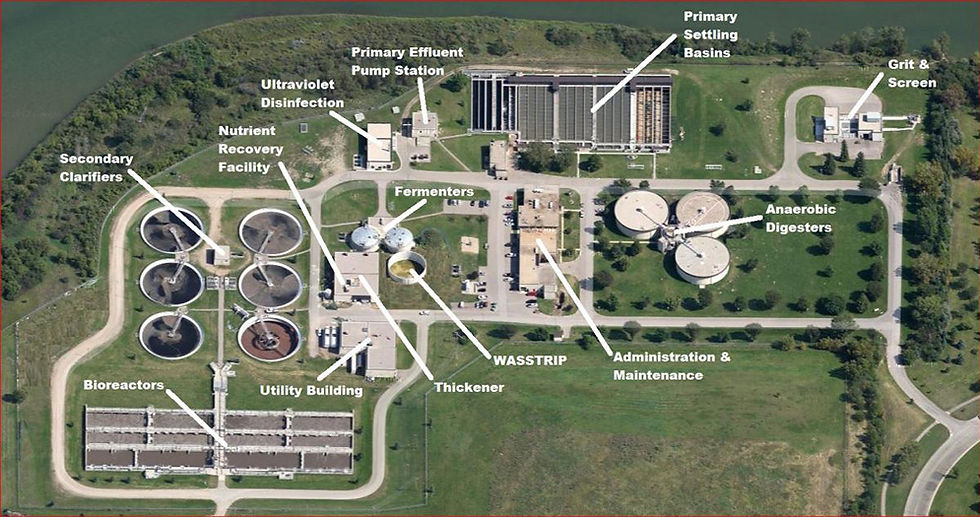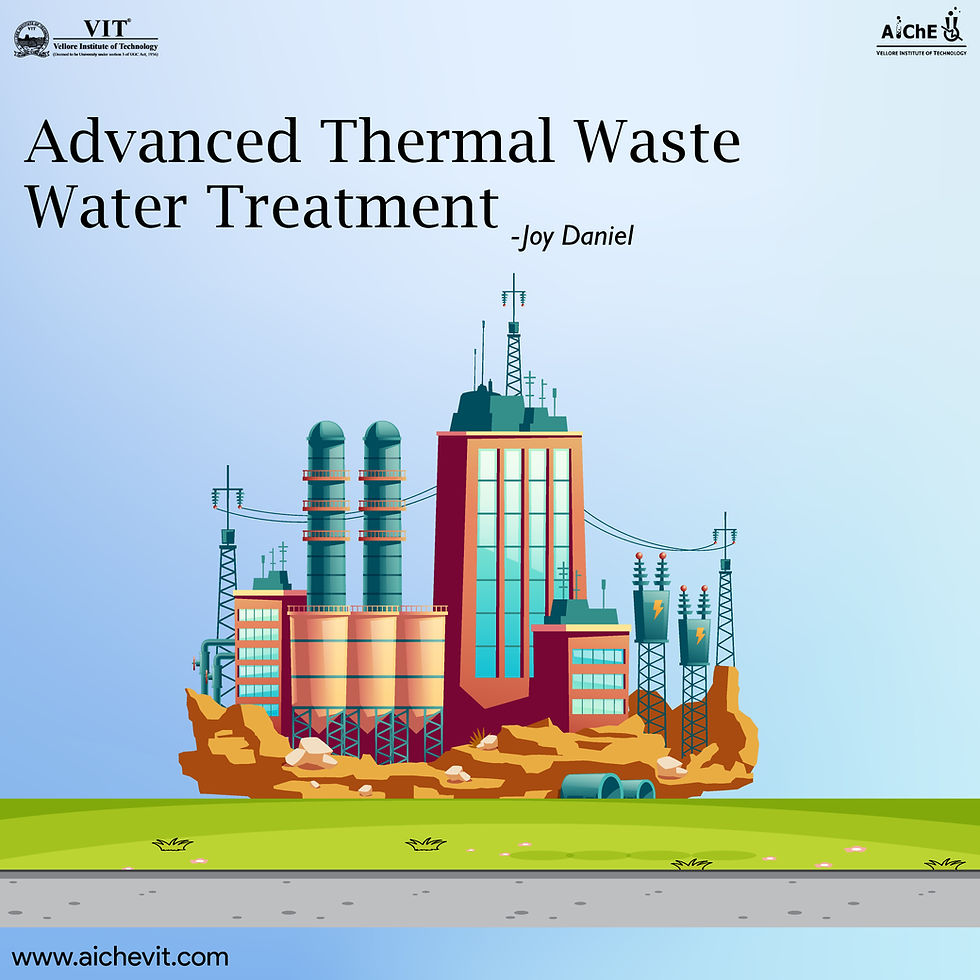Clearing the Effluents
- AIChE-VIT

- Sep 21, 2019
- 7 min read
- Riddhi Goel
The United States Environmental Protection Agency defines effluents as "wastewater - treated or untreated - that flows out of a treatment plant, sewer, or industrial outfall, basically the wastes discharged into surface waters.” Estimations show that every year 1.8 million people die due to waterborne diseases. A large part of these deaths can very well be attributed to improper sanitation. It is imperative that the talk around the treatment of these effluents makes the news since wastewater treatment is an important initiative which has to be taken more seriously. Thus, enforcing improvements in ETPs has become an unavoidable necessity today for the betterment of current and future generations alike.

Wastewater treatment is a process, wherein the contaminants are removed from wastewater and household sewage, to produce solid waste suitable for discharge or reuse. Some of the important types of waste-water treatment process are as follows: Effluent Treatment Plants (ETP), Sewage Treatment Plants (STP), Common and Combined Effluent Treatment Plants (CETP). The main aim here is to discuss how the effluent treatment plants work, about their pros and cons, their longevity and the adaptations they require for better operation and management, and to focus more on knowledge development about how the newer technologies of wastewater treatment are more efficient and preferable in large scale industries of today.
Effluent Treatment Plants (ETPs) are used in the pharmaceutical and chemical industry to purify water, remove any toxic and non-toxic materials or chemicals from it and for environmental protection. The effluent treatment plants are used in the removal of high amount of organics, debris, dirt, pollution, toxic, non-toxic materials, polymers, etc. from drugs and other medicated stuff. The ETP plants use drying and evaporation methods, and other auxiliary techniques such as centrifuging, filtration, incineration for chemical processing and effluent treatment. The treatment of effluents is essential to prevent pollution of the receiving water and thus, the effluent water treatment plants are installed to reduce the possibility of pollution. It is well known that biodegradable organics if left unsolved, the levels of contamination in the process of purification could damage bacterial treatment beds and lead to pollution of controlled waters.
Reviewing proposed ETP designs on the basis of: a) whether the treatment process outlined is likely to meet the treatment requirements of the industry; b) whether the treatment components of the ETP are of the correct capacity; c) whether the units are likely to operate effectively; and d) whether the elements of the ETP being proposed are necessary. The efficiency and effectiveness of an ETP depend on several factors. The production capacity of the unit, the volume of effluent produced and over what timeframe and characteristics of effluent are all important factors in ETP design, construction, and management.

Before reviewing the operation of the ETP, companies should take action to minimize the amount and strength of the effluent created by production processes. Producing less effluent in the first place will not only reduce the demands made on the ETP, but also save both money and effort. The main purpose of extending support to existing ETP Operation and Management is to improve efficiency and if possible, to try and reduce the running costs of the ETP. Adaptation of design to improve efficiency and reduce cost includes performing changes like recommending bypassing the unnecessary chlorination unit and segregating the different waste‐streams to avoid the unnecessary treatment of waste already meeting discharge standards. Not only do ETPs need more energy to operate with minimum results to show for, but the annual maintenance required is one of the main concerns when we compare the annual productivity one achieves. Also, the sludge generated by effluent treatment needs to be further processed and disposed of safely. It is the by‐product of the effluent treatment process, produced in the form of solid waste. Sludge handling and processing is becoming a big issue to the companies which are running their ETP continuously or intending to run it continuously. In fact, it is such an important issue on which research is going on all over the world. Some knowledge of the sludge characteristics is required to select the best appropriate means of sludge handling and processing.
Although ETPs still continue to be used in many parts of the world, but, the problems and limitations they cause, are big hindrances to large scale industries, which is why advancements in wastewater management are a big talking point due to their obvious advantages over the existing ETPs.
It is generally realized that numerous areas on the planet have rare water assets. In these zones, the groundwater springs are likewise observed to be in a basic condition because of over-abuse. That is the reason, in such locales, the reuse of wastewater is a typical practice and the skilled specialists embrace numerous approaches to empower its reuse. Enactment executing the recovered wastewater reuse is moreover requesting as far as quality and wellbeing and security, which has brought about the use of new advances for water treatment and filtration. Among the new rising advancements shows up the utilization of small scale and ultrafiltration films as exceptionally effective frameworks, which are monetarily practical for acquiring excellent reused water.

Membrane bioreactor (MBR) technology is based on the combination of conventional activated sludge treatment together with a process filtration through a membrane with a pore size between 10 nm and 0.4 microns (micro/ultrafiltration), which allows sludge separation. The membrane is a barrier that retains all particles, colloids, bacteria, and viruses, providing complete disinfection of treated water. Furthermore, it can operate at higher concentrations of sludge, which significantly reduces the volume of the reactors and sludge production.
MBRs represent an important technical option for wastewater treatment and reuse, being very compact and efficient systems for separation of suspended and colloidal matter and enabling high quality, disinfected effluents to be achieved. A key advantage of these MBR systems is complete biomass retention in the aerobic reactor, which decouples the sludge retention time from the hydraulic retention time, allowing biomass concentrations to increase in the reaction basin, thus facilitating relatively smaller reactors. In addition, the process is more compact than a conventional activated sludge process, and the feed wastewater only needs to be screened (1-3 mm) just prior to removal of larger solids that could damage the membranes.
Throughout the most recent two decades the innovation of layer bioreactors (MBRs) has arrived at a huge piece of the overall industry in wastewater treatment and it is relied upon to develop at a compound yearly development rate (CAGR) of 13.2%, higher than that of other trend-setting innovations and other film forms, expanding its fairly estimated worth from $ 337 million of every 2010 to 627 million of every 2015 (BCC, 2011). High-impact MBRs speak to a significant specialized alternative for wastewater reuse, being extremely conservative and proficient frameworks for isolating suspended and colloidal issue, which can accomplish the most elevated gushing quality measures for purification and explanation.
The advantages of this process over the conventional activated sludge process are widely known, among these, one of the most cited is the reduction in sludge production which results from operation at high solid retention time. Generally, we would expect that microorganisms subjected to severe substrate limitation should preferentially meet their maintenance energy requirements instead of producing additional biomass. This substrate limitation imposed on an MBR, by operating at low food-to-microorganism ratios, should modify the activity and characteristics of the sludge and could be the key factor for determining the process performance, particularly the membrane filtration.

Biokinetic models are widely used to design the activated sludge process. Knowledge of biokinetics parameters allows modeling of the process including the substrate biodegradation rate and biomass growth. At low growth conditions, as is demanded in MBRs, other processes apart from microbial growth have to be taken into consideration. These have been recognized as the maintenance energy requirement, endogenous respiration, and subsequent cryptic growth.
The current penetration in the wastewater treatment market of the membrane bioreactors gives an idea of the degree of maturity reached by this technology. The most cited market analysis report indicates an annual growth rate of 13.2 % and predicts a global market value of $ 627 million in 2015 (BCC, 2011). Actually MBRs have been implemented in more than 200 countries (Icon, 2008). Particularly striking is the case of China or some European countries with an implementation rate of over 50% and 20%, respectively. This technological maturity in urban wastewater market is also reflected in two main issues: the diversity of technology suppliers and the upward trend in plant size. Since 1990, the number of MBR membrane module products has grown exponentially reaching over more than 100 countries.
No wastewater treatment can be declared absolutely perfect and hence, the highly-rated MBR technology is also limited by its high costs, both capital and operating expenditure, mainly due to membrane installation and replacement and high energy demand. Selecting an appropriate permeate flux, membrane scouring, methods of physical cleaning, and chemical cleaning. Membranes are very sensitive to damage with coarse solids such as plastics, leaves, rags and fine particles like hair from wastewater. In fact, a lack of good pre-treatment/screening has been recognized as a key technical problem of MBR operation. For this reason, fine screening is always required for protecting the membranes.
Effective management and control of the processes used for effluent treatment will not only help in reducing the operating costs and thus increase profits, but it will also ensure the achieving of more effective compliance with legislation and will support with improving the company’s public image. The steps to effective effluent management are characterizing all effluents produced on-site, implementing a waste minimization program to reduce the volume and strengths of effluents, incorporating in-process conditioning and treatment, where appropriate and to determine and install segregation facilities to tailor treatment options.
Keeping up to date with the current technology, the fact that membrane technology is a big hit today withstanding, not only puts you on the right path to compete in the global market, it also helps provide better service to the society in form of improved goods than the ones they had before a particular technology came into existence. To relate with the concerned topic at hand, there is no better wastewater treatment than MBR technology as of today, and as statistics correctly show, those who have incorporated the better technology at hand have reaped rewards. Processing of quality water with lesser limitations and better efficiency than almost every existing process is always an easy yes, of course.





Comments